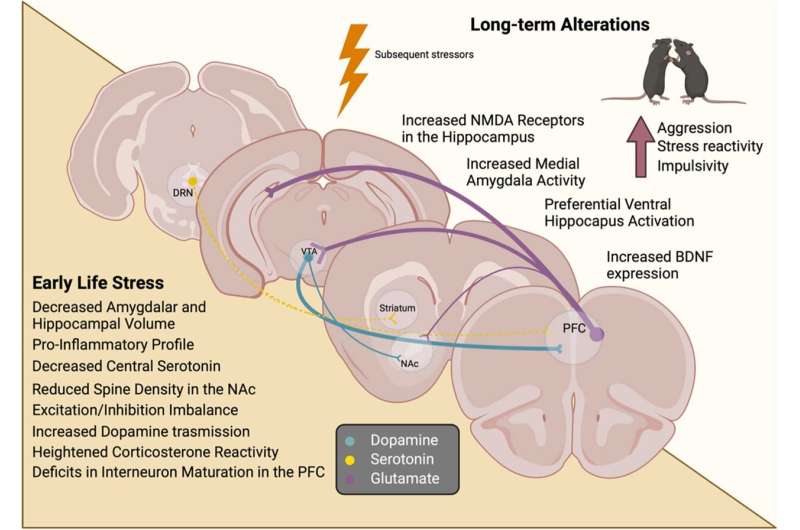January 2, 2024 feature
This article has been reviewed according to Science X's editorial process and policies. Editors have highlighted the following attributes while ensuring the content's credibility:
fact-checked
trusted source
proofread
Exploring the link between early life stress and maladaptive behavior across species

Adverse early experiences, such as parental neglect, abuse, the death of a loved one, or other traumatic events, are known to influence how humans will behave as adults. For instance, studies have found that victims of childhood abuse are at a higher risk of developing mood or conduct disorders characterized by altered social behaviors, such as aggressive, withdrawn or mistrustful tendencies.
Shedding light on the link between early life stress and maladaptive behaviors could be of great value, as it could help to devise new interventions designed to educate parents, protect children from abuse, or support people who had adverse childhood experiences. A research group at Icahn School of Medicine's Nash Family Department of Neuroscience and Friedman Brain Institute recently reviewed existing literature on this topic, particularly studies exploring the link between early life stress and aggressive behaviors in various animal species. Their review is published in the journal Neuroscience Research.
"Years of basic, clinical, and now translational research have afforded us a well-rounded, longitudinal perspective on how exposure to early life stressors alter long-term behavioral and biological adaptations," Lyonna F. Parise, co-author of the paper, told Medical Xpress. "Our goal was to highlight that these deviations from expected behavioral trajectories are observed in species-specific social interactions, including the reorganization of social structures, avoidance of social stimuli, and heightened aggressivity."
Several past studies have highlighted the link between early exposure to stressful events and the development of aggressive behavioral tendencies. Notably, aggressive behaviors can be displayed by people diagnosed with various mental health disorders, including substance use disorders and antisocial personality disorder.
"We set out to highlight that maladaptive social behaviors are also primary symptoms of various psychiatric conditions in adults," Parise explained "We thus provided human examples of early life adversity to parallel the several preclinical models in mammalian and non-mammalian species being employed to mimic various aspects of adverse experiences that humans endure during childhood and adolescence."
In their paper, Parise and her colleagues outline some of the primary findings that linked stress exposure early on in life with aggression in adulthood, both in humans, other mammals, and non-mammalian animal species. They observe that most animals displaying these behaviors appear to exhibit deficits in the processing of rewards.
"The standardization of animal models has allowed us to better understand the underlying mechanisms consequent of early life insults which promote dysregulation of adulthood stress responses," Parise said. "Years of work collectively point toward alterations in the networks that promote 'appropriate' social engagements, with evidence of increased excitotoxicity, reduced cortical engagement, and dysregulated neurotransmitter release."
When they reviewed past studies, Parise and her colleagues found that chronic exposure to stressful events during early development can increase the level of corticosterone, a steroid that regulates stress responses, in many animal species, while also prompting changes in the expression of neurotransmitters and neuromodulators. In addition, adverse early experiences have been linked to alterations in the organization of various key brain regions, including the hypothalamus, hippocampus and amygdala, and their communication with parts of the brain that process rewards.
"While there have been important therapeutic advancements, including deep brain stimulation for more persistent cases, our preclinical work dissecting the biology that drives aberrant social behavior could help guide the development of personalized treatment options," Parise added. "Indeed, using rodent models of aggression or social stress we have previously identified key differences in how males and females engage socially relevant neuronal networks and hope to expand this work by employing similar analyses in complex social behavior models."
The recent work by Parise and her colleagues delineates some of the biological mechanisms influenced by chronic stress early in life, which could ultimately explain the aggressive behavioral patterns that can emerge in affected adult animals and humans. In their next works, the researchers plan to continue investigating the neural underpinnings of aggression both in males and females, with the ultimate goal of informing future interventions aimed at modifying maladaptive behaviors.
More information: Lyonna F. Parise et al, Early life stress and altered social behaviors: A perspective across species, Neuroscience Research (2023). DOI: 10.1016/j.neures.2023.11.005
© 2024 Science X Network




















